Abstract
In the school environment, adolescents face various forms of violence that involve physical beatings, vulgar language and humiliation within the group they belong to, to online violence - cyberbullying. Thus, along with the traditional forms of violence in the school environment, harassment, harms, new forms of manifestation of this behaviour were identified, namely the behaviour of cyberbullying in adolescents. Given the early behaviour of the current generation of adolescents and their high social skills, it is necessary to identify both early forms of traditional violence in schools and new forms of cyber bullying, by developing effective prevention and intervention strategies. The research question of the study focused on finding answers regarding the prevalence of bullying and cyberbullying in students in the observation and guidance cycle. The main goal is to reveal a profile of students from schools in Cluj County. The study was conducted on a sample of 96 students in grades VII - IX. Two questionnaires were used to conduct the study, which contained several types of closed-ended, multiple-choice or open-ended questions. The data processing was performed with the help of the statistical program IMB SPSS Statistics 23. The research results indicate some important aspects of how students perceive the phenomena of bullying and cyberbullying at school level and how they are affected by this phenomenon. Most students feel good at school even if there are some behaviour that do not do them good, they recognize this.
Keywords: Emotional bullyingphysical bullyingcyberbullyingprevalenceaggression
Introduction
In Romania, in school, 3 out of 10 children are excluded from the group of colleagues, 1 out of 4 children has been humiliated at least once in front of colleagues and 3 out of 10 children are threatened, physically, with beating, abruptness or hitting by colleagues. These data were captured by the first national sociological study, launched by Save the Children Organization (Save Children Romania, 2016), an organization that monitors the phenomenon of bullying. This reality, which appears more and more frequently in Romanian schools, involves both physical and verbal aggression, sometimes exclusion from the group or social isolation, humiliation, destruction of personal property, ban on talking to another colleague. Bullying in the school environment can take many forms. We can visualize, identify concrete forms of verbal and physical aggression, but it is very important to be aware of the existence of hidden forms of bullying, because they are most commonly used by aggressors and can not be easily identified by teachers and parents (Beldean-Galea et al., 2016).
One form of high-risk aggression in the development of emotional intelligence, regardless of the age of the students involved, is emotional aggression. This form of emotional aggression can be determined in the school space, primarily by the "actors involved" teachers and students.
Social isolation is a form of hidden bullying, in which the aggressor encourages others to ignore the victim or even humiliate her. However, a much more hidden form than bullying is cyberbullying which takes place in the virtual environment by sending intimidating messages to the victim through social networks, telephone, media violence. Studies conducted in Romania on the impact that television programs can have on children, have shown that they often do not differentiate between Good and Evil, as moral values (Drăgan et al., 2009). To explain the forms of aggression in the school environment, Mureşan and Porkolab (2017) have introduced two notions - mature bullying that represents a form of aggression practiced by a part of the teaching staff as a form of exercising control over students by repeatedly highlighting their mistakes, unconstructive criticism, high level voice, physical aggression - all due to the lack of teaching experience and poor psycho-pedagogical training; and immature bullying, a form of violence practiced between students repeatedly, aggressively both physically and verbally, up to more subtle form of harassment created through social networks (Mureşan & Porkolab, 2017).
Virtual intimidation can be said to be similar to verbal, relational, the difference being the environment in which it takes place - online, online posting of private messages, personal information, pictures, sending messages in the form of emails using the victim's name (Benga et al., 2015).
In recent decades, the phenomenon of bullying has been the focus of attention and the global academic and psychological community has investigated both the phenomenon from different perspectives and implemented important anti-bullying projects at EU level. A recent study under the EU-funded European Anti-Bullying Campaign shows that 51% of students have experienced bullying in Lithuania, 50% of students in Estonia, 43% in Bulgaria, 31% in Greece, 25% in Latvia and 15% in Italy. The numbers indicate the growing dimension of bullying in EU communities.
Problem Statement
More and more children, adolescents, adults, parents and teachers face the phenomenon of bullying almost every day at home, at the playground, in classrooms, on the Internet, in communities and beyond. Bullying is not a recent phenomenon, but one that has existed for generations in a variety of forms. A person is intimidated when he is repeatedly exposed, for a period of time, to the negative actions of one or more persons.
Research Questions
The purpose of implementing a focus group is to give students the chance to express their views on school safety and bullying. Effective prevention of bullying must be evidence-based and must always involve students. Key questions for students in a safe place through which the right moderator can learn not only the bullying trends in a school, but also their ideas for making the school safer. Students will also reveal what bullying prevention strategies work and can provide concrete suggestions for improving the school climate and reducing bullying among peers.
Purpose of the Study
The main purpose of this approach was to ascertain, using the focus-group method, the prevalence of the bullying phenomenon in their school, the forms of bullying, the effects that bullying has on the victim, the aggressor, but also the witness. The number of participants in the focus group was 96 students (Nf = 53, Nb = 43) aged between 13-15 years coming from urban areas.
Research Methods
The students were formed into four focus groups that were coordinated by two teachers. Each teacher received instructions for implementing the questionnaire developed for this research. The groups of students organized to apply the focus-group method had 90 minutes allocated to answer the questions and indicate their answers. Students were encouraged to answer as honestly and without restraint as possible in order to mention as clearly as possible the problems they encountered in their school. Their responses were recorded and statistically processed using qualitative and quantitative results detection tools.
The proposed objectives were:
recording behaviours that cause discomfort, confusion, humiliation,
reporting the incidence of bullying episodes at school level,
analysis of the way in which students perceive the effects produced by bullying on the victim, the aggressor, the witness,
registration of bullying prevention methods implemented at school level.
Findings
The first of the questions referred to how the children feel at school measures on a scale of 1 being very bad at 10 - very good. The average was 7.46 which indicated how the children feel at school taken as a whole.
In Figure
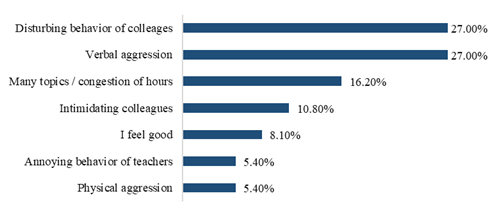
The forms of bullying that cause discomfort; confusion, humiliation, and that manifest in their class / school are represented in Figure
In the Figure
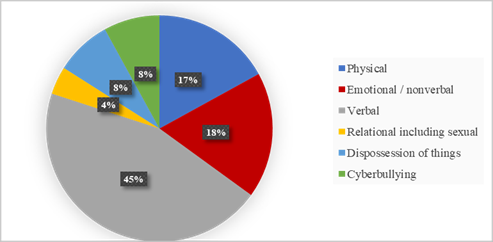
The frequency of reported bullying / cyberbullying known among peers in school / class reveals that 29.17% of students report bullying as being present daily in school, and 47.92% of them rarely meet this phenomenon in school (Figure
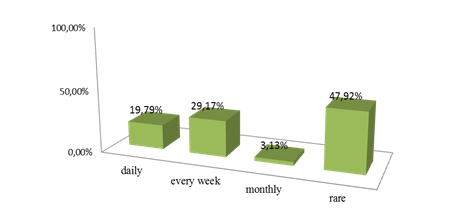
An important aspect in the student's school activity is the communication he has with the teachers in his school. To the question “Specify how often you communicate with teachers / leaders / parents about aggressive or specific bullying / cyberbullying behaviors encountered in your school / class” 68.75% of students reported that they rarely communicate with their teachers (Figure
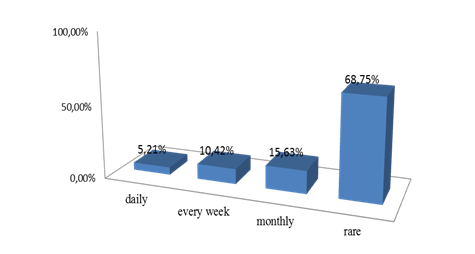
regarding aggressive behaviors
Behaviors that cause discomfort, confusion, humiliation are represented in Figure
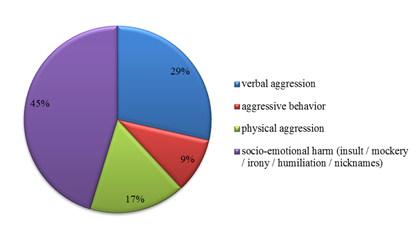
Another point of interest was the practical measures applied by the school management / principal / teacher / psychologist to combat bullying / cyberbullying in their school / class. Figure
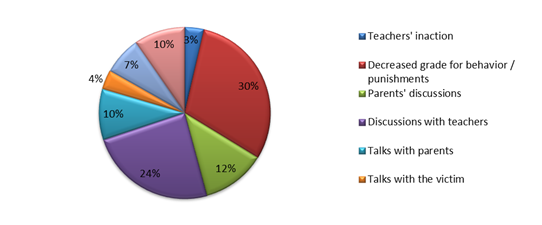
It was wanted to identify the students' opinion to mention the effects produced on the victim (figure
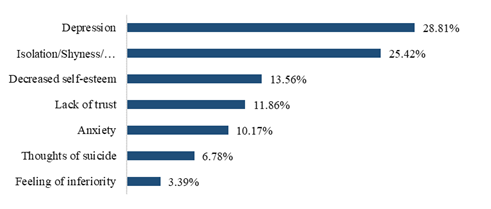
figure
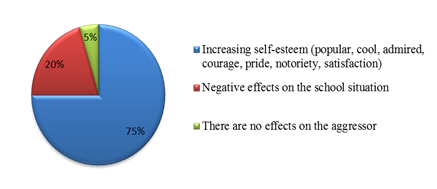
The available person to whom the student can turn in case of an aggression is illustrated in figure

Students believe that the phenomenon of bullying affects their self-image and school results. The effects of bullying can lead to decreased self-esteem, self-confidence, withdrawal, insecurity, lack of concentration in class and thus lead to unsatisfactory school results.
Opinions are divided when it comes to the intervention of other people who have managed to resolve the conflict peacefully following an episode of bullying. Parents are the ones who are able to intervene from what the student’s report, at the same time we have the involvement of teachers in certain cases, but most of the time the students are left with the phenomenon of unresolved bullying. They complain that teachers do not get involved because they do not have time or care.
Concrete actions to implement the strategy for preventing the phenomenon of violence / bullying are known by 32% of, the rest are not aware of such measures or revealed that there are no measures implemented at the institution level.
According to the types of bullying behavior, as a form of violence that manifests in their school there are all forms of bullying aggression interaction, prevalent being those between student-student, so that 61% of students said this. What bothers them the most is the behavior of his other classmates, the verbal aggressions practiced largely at school by some of the students. A place in dissatisfaction is also occupied by the "congestion" of classes and "homework", this being a feature in many other schools. The form of verbal bullying is encountered by most students during school hours, followed by emotional / nonverbal bullying and physical bullying involving blows, beatings, pushing, obstructing. The forms of bullying happen with a daily or weekly frequency, even if the severity of the phenomena does not have the same intensity, they are perceived as disruptive phenomena.
Conclusion
One of the problems is the lack of communication between students and qualified people within the school. Behaviours that cause discomfort, confusion, humiliation were reported by students as mostly emotional damage such as insult, mockery, irony, humiliation, nicknames followed by verbal aggression and physical aggression. The practical measures applied by the school management to combat the phenomenon of bullying in school represent largely the decrease in grades, punishments and warnings with expulsion followed by the announcement of parents in case of repeated bullying, discussions with the aggressor, the victim, their parents, but students complain that there is no action or even inaction of teachers. The effects of bullying on the victim show that depression comes first, followed by isolation and withdrawal, low self-esteem, lack of confidence, increased anxiety, but also drastic thoughts of suicide or feelings of inferiority to colleagues. From the point of view of the participants, the aggressor has a high self-esteem revealed by the use of the words “popular”, “cool”, “admired”, “brave”, “proud”, having a satisfaction when he bullies his victims, but some of the students did not reveal that the negative effects are present in school situations, and a small part of the students participating in the study revealed that there are no effects on the aggressor.
In case of an episode of bullying students mostly turn to the school counselor followed by teachers and parents, to a small extent they turn to the management of the school or the dedicated line for assistance known to them. The vast majority of students believe that the phenomenon of bullying affects their self-image and thus students' school results are severely affected by lack of confidence, concentration on time and insecurity. The witness is a person who from the point of view of students' children could intervene in the bullying episode but there are at least three types of witness: he intervenes by involving teachers, ie he is the witness so he considers what happened and will say with an objective eye on what happened to the teachers, will remain impassive or will even become by his behavior complicit in the act of bullying with the aggressor.
Concrete actions implemented as a strategy to prevent the phenomenon of bullying are few in number so that very few children have been able to reveal this, the vast majority of them say they are unaware of such measures or they do not exist. The type of bullying between students is prevalent in school followed by bullying between student and teacher, a majority of bullying between teacher and student, although there are all types of bullying at school level.
More and more evidence is confirming that the fact that a target of childhood bullying endangers the well-being of young victims and contributes to the development of mental health problems early in life. Not only do victims of bullying have increased symptoms of anxiety and depression in childhood and adolescence, but they also have high rates of self-harm, suicidal thoughts, and suicide attempts and psychotic symptoms. Victimization of bullying is associated with the child's poor outcomes, in addition to the effects of previous adjustment problems, as well as genetic and family confusions, which indicates an environmental-mediated effect on the development of mental health problems in childhood. As a result, bullying is increasingly seen as bullying and neglect as a form of childhood abuse.
References
- Beldean-Galea, I., Mireştean, I. M., Irimie, S., Samoilă, C., Sandu, P., & Rusz, A. (2016). Bullying behavior in school – specific form of school violence. Revista de Medicină Şcolară şi Universitară [Journal of School and University Medicine], 3(3), 31-39.
- Benga, O., Băban, A., & Opre, A. (2015). Strategii de prevenție a problemelor de comportament [Behavior prevention strategies]. Publisher ASCR.
- Drăgan, I., Ștefănescu, P., Povară, A., & Velicu, A. (2009). Reprezentarea violenței televizuale și protecția copilului [Representation of television violence and child protection]. Centrul de Studii Media și Noi Tehnologii de Comunicare [Center for Media Studies and New Communication Technologies]. Publisher Vanemonde
- Mureşan L., & Porkolab A. (2017). The effect of bullying and cyberbullying in primary school students communities. Education, Religion, Family in the contemporary society. Lap Lambert. Academic Publishing.
- Save Children Romania. (2016). Bullying-ul în rândul copiilor. Studiu sociologic la nivel national. [Bullying among children. Sociological study at national level]. https://www.salvaticopiii.ro/sci-ro/files/10/10551dfa-f0b2-4cb0-a103-08d811dc31a9.pdf
Copyright information

This work is licensed under a Creative Commons Attribution-NonCommercial-NoDerivatives 4.0 International License.
About this article
Publication Date
31 March 2021
Article Doi
eBook ISBN
978-1-80296-103-4
Publisher
European Publisher
Volume
104
Print ISBN (optional)
-
Edition Number
1st Edition
Pages
1-536
Subjects
Education, teacher, digital education, teacher education, childhood education, COVID-19, pandemic
Cite this article as:
Mureșan, L. M., & Stan, C. (2021). Bullying And Cyberbullying From The Perceptions Of Students In Cluj County. In I. Albulescu, & N. Stan (Eds.), Education, Reflection, Development – ERD 2020, vol 104. European Proceedings of Social and Behavioural Sciences (pp. 44-52). European Publisher. https://doi.org/10.15405/epsbs.2021.03.02.5

